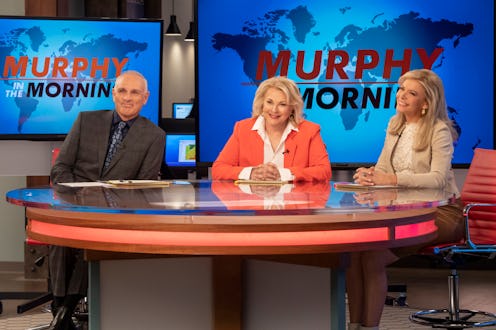Entertainment
Here's Why The 'Murphy Brown' Reboot Is The Perfect Show For The Trump Era

Journalists have long been under attack from those in power, but it wasn’t until Donald J. Trump arrived in the White House that the media was labeled as “fake news” and an “enemy of the people.” What’s a member of the press to do? Well, keep on fighting. That’s what Murphy Brown does in the reboot of the classic sitcom, and it totally works.
The first iteration of the show, which ran from 1988 to 1998 on CBS, didn’t exactly shy away from the tough topics. The original Murphy Brown covered everything from gun control and prisoner's rights to the environment to single motherhood, the latter of which found Murphy (and the show at large) embroiled in a public spat with then-Vice President Dan Quayle. Murphy was having a baby — a son, Avery, who is all grown up in the revival — alone, and out of wedlock, too, and, per the New York Times, Quayle lamented this storyline as the end of family values as we know it. He just couldn't believe that a woman could raise a child alone or that it was being done on national television. If only we could say that things have changed.
Quayle is mentioned in the premiere of the revival, perhaps as a reminder as to what Murphy Brown used to be capable of and what she can do now. In the episode, Murphy (like most of America) is enraged by the actions and laws and decrees coming from the White House, and so she polishes off her old microphone, grabs Corky, Frank, and Miles, and gets her old show back.
There are more than a few bad jokes — why do writers keep telling jokes about older people and their difficulties with technology? — but what the revival of Murphy Brown boils down to is encapsulating the flat-out rage that plenty of Americans feel in having to listen to untruths and sensational claims all day in the era of Trump and MeToo. This new Murphy wants the facts. She wants the facts, so she’ll give them to you. (The real ones, not the government-approved ones.)
Murphy’s fictional Twitter spat in the premiere with the President is hokey, but it underlines a key message — she’s the only newscaster, real or made-up — that will even go toe-to-toe with him. Murphy hones her rage into a marketable presentation of how the American people are being misled — the EPA chief shown in the premiere doesn’t stand a chance. She's really not playing.
In a world of news conglomerates where the man who owns your station may golf with the President (and boy, does he golf a lot), it’s hard for today’s anchors to throw themselves in front of the bus in order to promote the greater good.
Speaking out may mean certain career death, and the end of news as we all know it. According to Vanity Fair, creator Diana English sees the reboot of Murphy Brown as a way to drown out the dissent from the White House. “We want to educate people about what actual journalists do, and how they really have to verify things,” she said. “People don’t know this, because they believe the president, [who] says, They’re making it all up. Anonymous sources, they don’t exist!"
Two years ago, it was strange to think we would have to rely on fictional characters, from the nineties no less, like Murphy in order to highlight the dangerous ideas coming from Washington, D.C., but this is where we are now. Murphy shouts Dan Quayle’s name at the end of the premiere as a callback to the original series but also as a warning shot — she’s back, she’s pissed, and she’s not going anywhere.